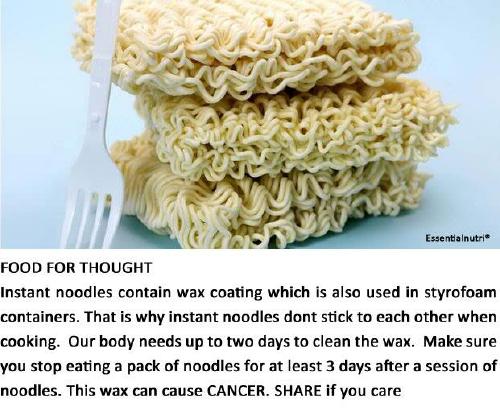[Collected via e-mail, 2000]
For our health concern, pls pass on the msg to those you know who loves Instand Noodles.
This is what I heard from a fellow colleague. Her nephew, who was studying in UK for about one and a half years, likes to eat cup-a-noodle. And guess what!
His doctor has found that there is a layer of wax lining the walls of his stomach. Seems that instand noodles that comes with foam containers contain an edible layer of wax. However, regular consumptions make it hard for our livers to clear the toxic.
This person died when he went for an operation to try to remove the layer. Pls do not boil the noodles in the container. Transfer to a glass bowl before you put the hot water.
[Collected via Facebook, 2012]
Styrofoam does an excellent job all on its own in keeping a hot liquid hot, and the thicker "heat 'n' serve" containers made from styrofoam stand up very well to microwave heating. There'd be no need to use a wax lining in such a container, because any use it could possibly serve is already well handled by the styrofoam.
As well, coating with wax the interior of a styrofoam container one knows will be used to heat a product would be rather pointless, because heat will melt wax, thus incorporating what was supposed to be part of the package into the foodstuff. Manufacturers of instant foods have a hard enough time convincing consumers that their stuff tastes good enough to eat without introducing melted wax into the equation.
Even if wax were used in the styrofoam containers, and even if some of it did get into the food, it wouldn't adversely affect the average person. (It might possibly cause a problem for infants or those with damaged or impaired digestive systems, but not ordinary, healthy adults.) Though it's not generally known, a number of candies routinely contain wax products. (Rowntree's "Smarties" and Just Born's "Peeps" immediately come to mind: carnauba wax is used in these products, as it is in candy corn.) In some confections, the wax is more upfront, as countless children who've indulged in wax lips and wax "soda" bottles will happily attest. To the best of our knowledge, none of the indulgers in these products have had to have the wax scraped out of their stomachs or developed cancer as a result (including my husband, who in the Halloweens of his childhood happily ate several pieces of wax lips a day).
This badly-constructed scare would have us believe someone's unnamed nephew in the United Kingdom died from a buildup of wax in his stomach. Wax, like just about anything else one swallows, is pushed through the digestive system and exits the body as part of a bowel movement. Nothing inherently special in wax would turn it into a permanent coating clinging forever to the stomach lining.
In October 2010 we spotted a similar
Beware of paper cups
Varun, an IT professional working in Technopark, was finding himself with an upset stomach every night. While normal medical checks revealed nothing wrong in him, deeper probes revealed the reason - his stomach was collecting significant amounts of wax. And doctors identified the villain - the ordinary paper cups he used for drinking his tea at his office pantry.
Disposable paper cups have become quite popular in office pantries due to the convenience it offers. What many overlook is the fact that these paper cups are coated with a tiny layer of wax, which is essential to prevent water from seeping into the paper. When very hot liquids are poured into this cup, the wax may disintegrate and a little may come off, which will promptly be sent along with the drink into our stomachs! While our body can discard minor amounts, over the long-term, it does become a problem.
So what can be done about it? You can try to bring your own glass cups. Glass is one of the least reactive materials in the world (remember acids are stored in glass vessels, blood samples are collected in glass plates - these are for a good reason). But glass does have the problem of breaking easily, so it requires good care. Ceramic cups are probably the best bet. Of course, you can also use your ordinary stainless steel cups, but never use plastic ones - its dangers are even worse than wax.


